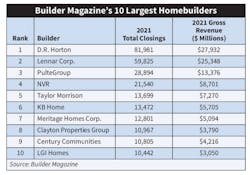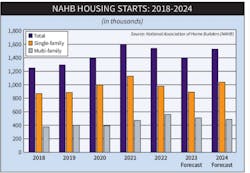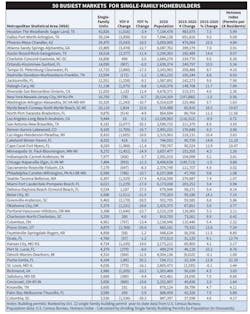WHERE THE RESIDENTIAL MARKET FITS IN
Every electrical distributor has a different take on the residential market. Many industrially-oriented distributors don’t deal with it. And in many mature suburbs, inner cities or other areas where new residential construction is nonexistent or at a standstill, the residential market may not provide many sales dollars at all. However, in a fast-growing Sunbelt suburb this may be a key market for a distributor.
What the market is depends on how you define it, too. For a residential lighting specialist that doesn’t sell much pipe and wire, the residential market means selling replacement fixtures to homeowners or a “houseful” of fixtures to a new home buyer who has the builder’s lighting fixture allowance to spend.
The market for residential lighting fixtures sold through full-line electrical distributors, residential lighting specialists, home centers, hardware stores and department stores operates differently than other aspects of the electrical market, primarily because of the retail nature of this business and the fact that the customer is most often a homeowner. Despite massive competition from home centers in this market, distributors still expect to sell billions in residential lighting fixtures this year.
Lighting may be the most visible segment of the residential market, but the wiring system hidden behind the walls of your home generates far more sales for full-line electrical distributors. The key products in this segment of the residential market include service-entrance equipment; load centers; circuit breakers; connectors; fittings and fasteners; wiring devices and wallplates; building wire; service entrance cable; and low-voltage wiring for home entertainment centers and man caves, plus security, sound, intercom, phone and home networking applications. Look for residential electric vehicles charging equipment to provide more sales opportunities in the coming years, too.
INCENTIVES FOR SOLAR & RESIDENTIAL EV CHARGERS
Solar. Because the installation of a residential PV system can be very pricey and easily cost more than $30,000, the ROI can approach a decade. But the dynamics of the residential solar market have changed because of the tax incentives for homeowners in the federal government’s new Inflation Reduction Act (IRA), which passed Congress in Aug. 2022. These federal tax incentives, along local utility rebate programs and other local, county or state financial incentives can drive down that ROI.
Make sure any builders, contractors or homeowners that you work with are aware of what the IRA offers. Congress passed an extension of the Investment Tax Credit (ITC) in the IRA, raising it from 26% to 30% for the installation of residential PV systems installed between 2022-2032. (Systems installed on or before Dec. 31, 2019 were also eligible for a 30% tax credit.) The ITC will decrease to 26% for systems installed in 2033 and to 22% for systems installed in 2034. Expenses covered by the ITC include the solar panels, contractor labor and installation costs, balance of system (BOS) equipment including wiring, inverters and mounting equipment.
The tax credit expires starting in 2035 unless Congress renews it. For more information on the ITC, go to www.energy.gov/eere/solar/homeowners-guide-federal-tax-credit-solar-photovoltaics.
According to the “U.S. Solar Market Insights Q3 2022” report published by Wood Mackenzie and the Solar Energy Industries Association (SEIA), “The residential solar segment set a record for the fifth consecutive quarter with nearly 180,000 American households installing solar in Q2. The IRA will drive an additional 7.3 GW of residential solar capacity over the next five years, and the new stand-alone storage tax credit across all market segments is expected to improve grid reliability.”
As with solar equipment, the federal government offers an impressive tax credit to homeowners for the installation of EV charging equipment. According to an article in Kiplinger, if you install a residential EV charger, the IRA tax credit is 30% of the cost of hardware and installation, up to $1,000. In 2023, incentives are also available for the installation of bi-directional EV chargers, which allow homeowners to send electricity from the battery in their EV back out onto the grid and get paid for the power they produce (www.kiplinger.com/taxes/605201/federal-tax-credit-for-electric-vehicle-chargers).
Make sure your customers know that homeowners can also tap into financial incentives for the installation of residential EV charging equipment from their local utility, as well as various state or county incentives. BriteSwitch, which first became well-known in the electrical business for its database of rebates and financial incentives for energy-efficient lighting, now offers the same for EV charging equipment. Check out www.britewitch.com for more information.
Residential battery storage. Another trend that can mean new business for residentially oriented electrical contractors is residential battery storage. Homeowners who want to store the electricity they produce from solar panels are installing Generac PWRcells or Tesla Powerwalls. The Powerwalls can also charge EVs in the event of a power outage. Starting in 2023, battery storage equipment for the home with a capacity of 3 kilowatt-hours (kWh) or more will be eligible for ITC tax credits.
MARKET SIZE
While the main focus in the electrical wholesaling industry tends to be on the much larger commercial and industrial markets, the residential market is still an important niche. It accounts for an estimated $27 billion to $28 billion in sales for 2023 — 19% of total distributor sales — according to data from Electrical Wholesaling’s 2023 Market Planning Guide.
When you measure the residential market by the number of single-family building permits, you will find it’s fairly consolidated, and a surprisingly small handful of MSAs accounting for a big share of the total market for single-family homes and multi-family projects. Through Oct. 2022, the 10 MSAs with the most permits accounted for roughly 29% of the total; the 25 largest markets accounted for 46%; the 50 largest MSAs had 63% of the national total; and the 100 largest MSAs (out of the 384 that had permit activity) had 80% of the action.
One of the most helpful tools for understanding which MSAs are growing the fastest is the “Housing Hotness Index,” which is the ration of building permits per 1,000 residents (See chart on page 17 for the 50 metros with the highest ranking). This allows you to size up market not based on their total housing activity, but by how much homebuilding is going on in the MSA compared to how many people live there.
When measuring a market with this ratio by comparing just single-family building permits to the population of a market, the 10 most active metros in terms of single-family housing in the “Hotness Index” are: Punta Gorda, FL; Myrtle Beach-Conway-North Myrtle Beach, SC-NC; Ocala, FL: North Port-Sarasota-Bradenton, FL; Cape Coral-Fort Myers, FL; Fayetteville-Springdale-Rogers, AR; Port St. Lucie, FL; Salisbury, MD-DE; and Deltona-Daytona Beach-Ormond Beach, FL.
Home builders and building product manufacturers must be tuned in to the sometimes finicky tastes of Millennials now entering their prime home-buying years in their 30s. When buying their first homes, townhouses and condos, they often load them with granite countertops, home entertainment wiring, high-speed Internet cabling and wireless home security systems. On the other end of the demographic spectrum, home builders need to provide retiring Baby Boomers with patio homes in maintenance-free communities and vacation areas and condos in downtown urban environments with the features they need.
In another sign of the sad state of the housing market, the NAHB/Wells Fargo Housing Market Index, which measures builder sentiment on a monthly basis is still dropping. Said NAHB in its analysis of the December HMI data, “Builder confidence in the market for newly built single-family homes posted its 12th straight monthly decline in December, dropping two points to 31 points. This is the lowest confidence reading since mid-2012, with the exception of the onset of the pandemic in the spring of 2020.”
“The silver lining in this HMI report is that it is the smallest drop in the index in the past six months, indicating that we are possibly nearing the bottom of the cycle for builder sentiment,” said NAHB Chief Economist Robert Dietz. “Mortgage rates are down from above 7% in recent weeks to about 6.3% today, and for the first time since April, builders registered an increase in future sales expectations.”
THE CUSTOMERS
To make the most of the residential market, you will need to first understand how the residential market works. Distributors work closely with two key customers in this market. For those distributors that focus on new construction and renovation, it’s the electrical contractor. Those companies with residential lighting showrooms focus on the homeowner. You also should get to know the builders in your market area. They work on a very tight production schedule, and the more you know about what they expect from their subcontractors, the better off you and your contractor customers will be. Builders also will sometimes buy bulk lighting fixtures and some other electrical products directly from distributors.
Depending on your region of the country, the national homebuilders may or may not have a major influence. The 2007-2009 recession crushed the homebuilding market, and the big builders aren’t producing houses at anywhere near the pace of the go-go years of 2005-2006, when the 200 largest home builders would close more than 500,000 new homes a year, according to Builder magazine (www.builderonline.com). Builder says in 2021 its 200 largest homebuilders closed 264,426 homes. Check out the chart above to see the 10 largest homebuilders in the Builder Online ranking.
If you look at the articles and posts on www.builderonline.com and other web-sites or publications aimed at home builders, the electrical products featured most often include high-end lighting and dimming systems, structured wiring systems, security systems and solar equipment. Manufacturers of these products are interested in forging relationships with builders, and you should be, too. Let’s now look at how to build relationships with these customers and buying influences.
Keep your promises. Distributors don’t have any great secrets in building relationships with electrical contractors. The biggest factor is, and has always been, service. Sure, contractors probably are more price-conscious than any other customers. And, yes, in the residential market they can get many of the products you sell from home centers. But for the long haul, contractors in your market need a dependable source for supplies. They need a distributor who may not always be the cheapest on each and every product but is the most reliable supplier in town.
As much as and probably more than any other customer, electrical contractors need the electrical distributor to deliver the right products on time and in the right location. Whether that be a delivery to the job site or a pick-up at the counter, the electrical contractor depends on the distributor to come through. That’s because contractors are on a tight time schedule at the job site. If they can’t finish the wiring, it has a chain-reaction effect, holding up the sheetrockers, painters, trim carpenters, and so-on down the line. If the electrical contractor is gumming up the works on a new home, his boss at the construction site — usually the general contractor or builder — isn’t going to be happy with him and may not use him in the next phase of the development. When this happens, you don’t need too much imagination to figure out what that contractor will think of the electrical distributor who made him late.
If builders in your market area are offering structured systems in their developments, this adds another step in the construction process — and puts additional pressure on the time line. That’s why many builders prefer to deal with one electrical contractor (and by extension, a sole source of power and home-networking or structured wiring supplies) to wire traditional wiring and structured wiring systems.
Don’t underestimate the power of credit. Why do contractors continue to do business with distributors when they can buy so many of the products they sell from Home Depot and other home centers? Credit is definitely one of the key reasons. Electrical contractors, particularly smaller electrical contractors, value a credit line from a dependable supply source. They need credit to keep working, and those credit lines on Visa, MasterCard or the store credit cards they get at the home centers only go so far.
Sure, contractors can often be a bigger credit risk than other customers. And while every distributor has either heard of or has had personal experience with an unscrupulous contractor running up a credit line and then skipping town, these horror stories are fortunately more the exception rather than the rule. Why do contractors have financial problems? Most often it’s because they fall victim to inadequate cash flow, the cyclical nature of the construction market, unscrupulous general contractors or poor business management on their own part.
Small residential contractors can turn into big commercial/industrial contractors. The saying, “From tiny acorns do mighty oaks grow,” applies directly to contractors. That new contractor in town doing a few residential service calls and trying to crack the new construction market may not add much to your company in the way of sales or profits today. But when these companies grow, they often expand past the residential market into the commercial or industrial markets. As they grow, so too does their buying power. They usually remember who did and didn’t offer them credit when they were just starting out, or who helped them get their business off the ground.
Teach contractors about business basics. Electrical contractors may be wiring wizards, but they often have trouble running a business. Accounting, bookkeeping and budgeting are usually second-nature to many electrical distributors. But contractors with no business background may struggle with these basic business skills. Have contractors sit down with your financial manager to get some basic business tips. Contractors often have a lot to learn about marketing themselves, too, and if your company has a marketing person on staff, he or she may have advice for customers in this area, too. Think about how you can help an electrical contractor market themselves with social media, if that’s one of your areas of expertise. You should also encourage these customers to join community organizations like the Kiwanis or Chamber of Commerce. This will give them the opportunity to develop professional relationships with accountants, bankers and lawyers they may someday need to use in their business.
Be prepared to offer some technical help. Although contractors have been pulling building wire for so long they can do it blindfolded, if an unusual installation does come up, they will need information from the distributor or the rep on that product. Providing technical assistance in newer markets like home theater, solar or home security can make a distributor look like a champ.
Get a grip on the technical basics. For salespeople and other employees new to the electrical market, or for those employees not too technically inclined, studying the residential market is helpful because the technical functions of these products are easier to understand than those in the commercial and industrial markets.
The first step in learning more about the fundamentals of electricity is to take a course or read one of the many books published on this subject. Manufacturers or trade associations also often provide training material on this area. The Electrical Products Education Course (EPEC) is a great training program offered by the National Association of Electrical Distributors (NAED), St. Louis. You can find more information on EPEC at www.naed.org. BlueVolt, Portland, OR, also offers a ton of technical training on products at www.bluevolt.com.
Once you feel comfortable with electrical theory, the next step is to get a feel for how these fundamentals actually work in an electrical system. Home wiring is a great place to see these fundamentals in action because residential systems use relatively basic electrical circuitry.
Work with builders to alert your contractor customers to opportunities in the VDV/structured wiring market. As mentioned, home builders may be looking for one contractor to handle power wiring and home theater or home networking systems for computers, home entertainment and security systems. If you can supply home-networking supplies along with traditional products, you can increase your sales-per-house.
Use what you learn in the residential market to build sales with other customers. The residential market is important to study because it offers a solid foundation in the customer-service basics that so often determine the distributor of choice in a particular area.
When dealing with homeowners, product knowledge separates distributors from home centers. The rules of the game may be somewhat different in the residential lighting market. But product knowledge is still a key value-added service that distributors can offer, whether they are selling fuses or chandeliers. This is an issue in the residential lighting market because of competition from home centers. It can be tough to compete with home centers on price for many of the basic fixture styles. To survive, many residential lighting distributors have focused on areas where home centers are weak such as the high end of the market, lighting design and on offering knowledgeable sales assistance.
PRODUCTS WITH AN EXTRA EDGE
Many of the electrical products used in residential construction haven’t changed much, but over the past few years, several relatively new products designed for the residential business have hit this market. You should make sure your contractor customers are aware of them. The most popular new products with electrical contractors these days seem to fall in three distinct categories: energy-saving products; labor-saving tools that allow them to save time, money and effort on the job site; and products required by the National Electrical Code or federal, state or industry safety regulations. Here are some examples of these products.
Arc-fault circuit interrupters (AFCIs). To reduce the number of electrical fires caused by parallel arc faults in branch circuit wiring, the National Electrical Code (NEC) requires arc-fault circuit interrupter (AFCI) protection device in an increasing number of residential applications. The AFCI protection device must de-energize and protect the entire circuit from an arc fault, according to Mike Holt, NEC consultant for EC&M magazine. The only device that can do this is an AFCI circuit breaker. For more information on AFCIs, check out Holt’s website at www.mikeholt.com and talk with your local electrical inspectors about where they are required in your market. With new construction, 120V, single-phase, 15A- and 20A branch circuits supplying all outlets in kitchens, family rooms, dining rooms, living rooms, parlors, libraries, dens, bedrooms, sunrooms, recreation rooms, closets, hallways, laundry areas and finished basements must be protected by AFCIs.
Surge suppression equipment. Because so many homes are loaded with sensitive electronic equipment, your customers may be asked to install surge suppression equipment at the service entrance.
Structured wiring systems. An exciting opportunity for your customers in the residential market is the installation of home networking for computers, security and home entertainment applications. Products for these applications include but are not limited to nonmetallic enclosures, data cable and jacks, USB receptacles, routers, modems and repeaters.
Cable fasteners. NEC Art. 300.4(D) requires that building wire be placed 1 1/4-inch from the edge of the stud to protect it from drywall screws or nails.
Metal-stud boxes and bushings. In some other areas of the United States, metal-stud construction has replaced wood studs as the primary frame of the building. This has created new sales opportunities for the bushings required to protect the cable from the sharp edges of the stud and for special boxes for steel-stud construction.
Weatherproof outlet covers. NEC regulation 410.57 requires the use of outlet covers for outside receptacles to protect them from the elements.
GFCI equipment. More areas than ever in the home must now be protected by ground-fault circuit interrupters (GFCIs) according to the 2023 National Electrical Code. Generally speaking, GFCIs are required in bathrooms, kitchens, basements and outdoors. Check out the product offerings from manufacturers of wiring devices and GFCI circuit breakers. A related NEC rule calls for GFCI protection of portable cords, which can be a nice add-on sale. Check ECM’s article for more information: https://www.ecmweb.com/national-electrical-code/article/21254614/top-changes-to-the-2023-national-electrical-code
Safety products. Hard hats, safety goggles and signage are just a few of the many safety products you can sell to residential electrical contractors.
Dimming products. Dimmers and dimming systems offer the opportunity to sell more than just a wall switch. For instance, contractors can “sell up” on residential service calls to replace a dimmer that’s burned out. Some manufacturers provide demonstration dimming systems for contractors to bring out on these service calls. This product niche is changing fast with the introduction of lighting control apps for smart phones that homeowners can use to control lighting when they are not in their homes.
Top-shelf lighting. LEDs are a giant factor in the residential market, as in other electrical business niches. In addition to ceiling fixtures and downlights, don’t forget applications for undercabinet lighting and landscape lighting.
USB outlets. Homeowners can never get enough USB charging stations for their smartphones and tablets, and the combo receptacles that offer USB ports are popular.
Generators. The increasing frequency of blackouts, brownouts and longer term outages caused by wildfires, hurricanes, tornados and other natural disasters has driven demand for generators in residential applications.
Solar panels & related equipment. Mentioned earlier
EV charging stations and storage batteries. As mentioned earlier, these products are emerging.
Poke-through outlets for granite countertops. This is an increasingly popular product area that offers access to power in the kitchen applications.
Snow-melting equipment. This product can be sold in upscale residential construction projects in the northern climates where snow and ice are a problem. Snow-melting systems are installed beneath walkways or driveways to keep these areas passable during colder weather.
Labor-saving tools. Electrical distributors have good reasons to carry tools that can save time and labor on the job. Contractors have an innate love for tools and are always interested in what’s new in this area. Tools are also an excellent product line to merchandise in the counter area because many customers buy them on impulse.
Solid sales opportunities abound in the residential market if you stick to the basics of customer service and explore these hot product areas.
Next issue: Commercial Market 101
About the Author
Jim Lucy
Editor-in-Chief
Over the past 40-plus years, hundreds of Jim’s articles have been published in Electrical Wholesaling and Electrical Marketing newsletter on topics such as the impact of amazonsupply.com and other new competitors on the electrical market’s channels of distribution, energy-efficient lighting and renewables, and local market economics. In addition to his published work, Jim regularly gives presentations on these topics to C-suite executives, industry groups and investment analysts.
He recently launched a new subscription-based data product for Electrical Marketing that offers electrical sales potential estimates and related market data for more than 300 metropolitan areas, and in 1999 he published his first book, “The Electrical Marketer’s Survival Guide” for electrical industry executives looking for an overview of key market trends.
While managing Electrical Wholesaling’s editorial operations, Jim and the publication’s staff won several Jesse H. Neal awards for editorial excellence, the highest honor in the business press, and numerous national and regional awards from the American Society of Business Press Editors. He has a master’s degree in Communications and a bachelor’s degree in Journalism from Glassboro State College, Glassboro, N.J. (now Rowan University).







